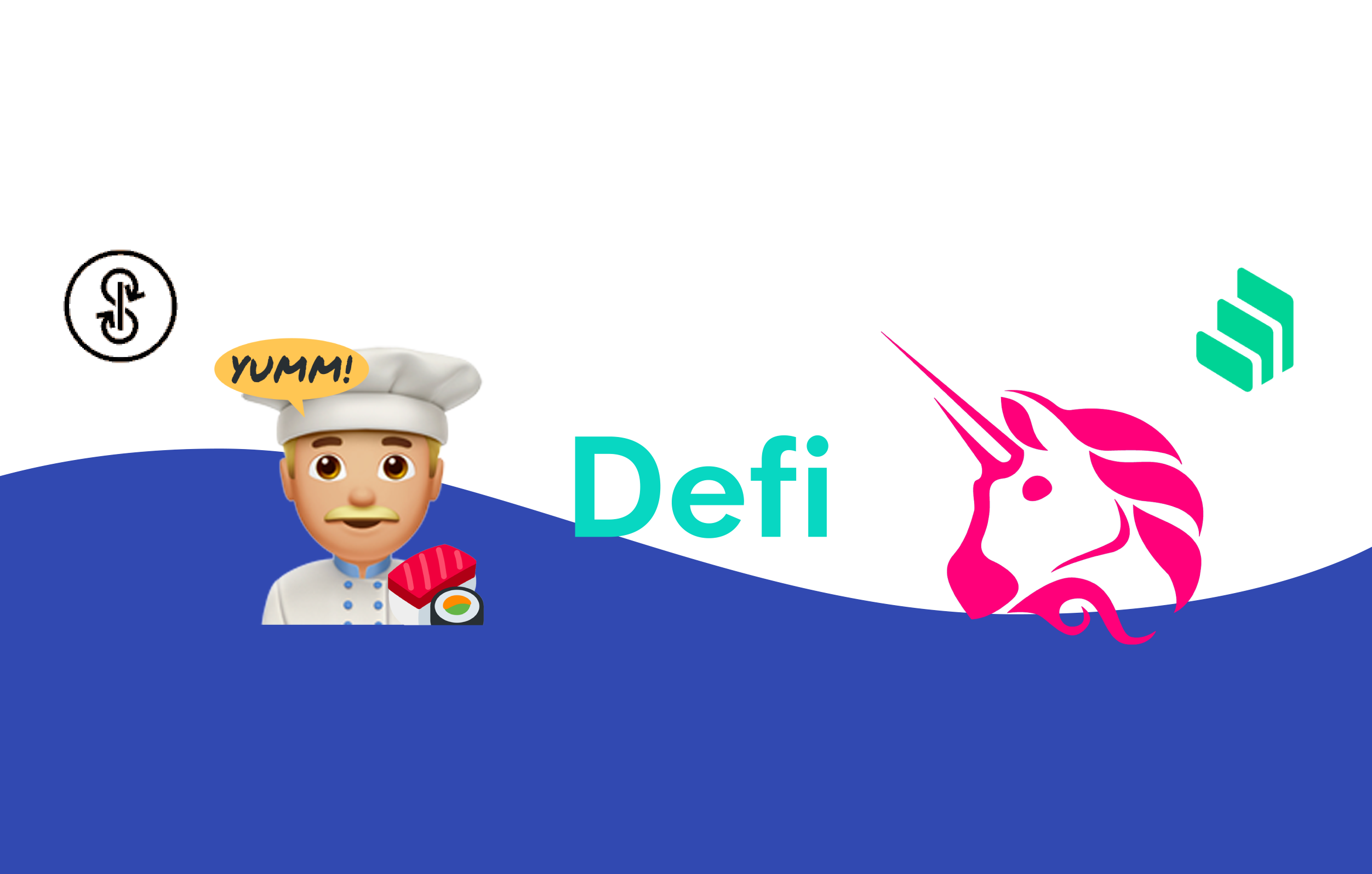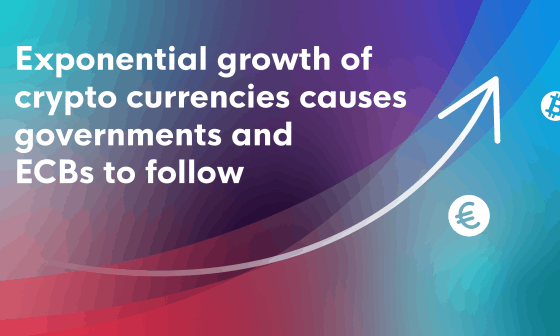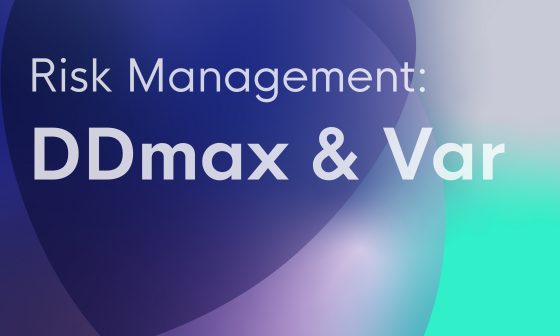DeFi, smart contracts, protocols, DApps – just a bunch of buzz words or rather innovative financial products? What is DeFi and who is it for? Besides being a trendy short form version of Decentralized Finance, it became an umbrella term for a group of blockchain projects focused on removing the middlemen from any financial services.
When banks are offering less than 1% interest and a brand new DeFi project can provide triple digits returns it becomes clear why DeFi is gaining traction all over the internet. As opposed to manipulated and costly centralized financial system, DeFi in its nature and foundation is a lot more millennial-friendly – low cost, efficient, and transparent.
The aim of crypto is to provide access to money and payments to anyone anywhere in the world. Taking it even further, DeFi movement makes open alternatives to traditional financial services like loans, savings, trading, and insurance possible to everyone with a smart phone and an internet connection.
Sounds exciting, perhaps even too good to be true, but it is a modern-day reality that is causing a paradigm shift in the global financial industry. The Total Value Locked (TLV) in the industry has recently exceeded $9 billion and will most likely cross $10 million mark later this month. It’s a clear signal of an evolution and that there is no better time than now to look into projects that have potential to expand in the coming years.
Role of decentralization
Let’s consider the current system where Federal reserve (FED) has control over the entire supply of US dollars affecting all people, corporations, and entities. From there US dollars flow to other centralized entities, such as banks. Each of these entities are in complete control of data and fund. All the major players in the current financial system have their own separate centralized systems. They do not necessarily communicate with each other efficiently – transferring money costs money, takes time, and is not efficient.
In contrast, crypto allows users to manage their funds and own the whole experience by replacing the banking system with decentralized network of computers. Since all changes in the protocol need to go through a consensus process that not one person has control over, the integrity of the network stays protected and remains safe to use. DeFi expands these principles to services that were before only offered through traditional financial institutions like lending, borrowing, and earning interest on savings. With the technology available each of these services can plug into one another to create new services that we never ever dreamed of before.
What is the underlying technology?
DeFi has blockchain technology at its core and is based on smart contracts that run on Ethereum. Imagine blocks of transaction data linked to previous blocks of data forming a chain represented by a blockchain concept. Smart contracts are lines of code that are stored on a blockchain and automatically execute when certain terms and conditions are met.
Smart contracts have attracted a community of developers to build apps around it. They are now called decentralized apps, or DApps and they are used to build far more sophisticated functionality than simply sending and receiving cryptocurrency.
And finally, before we continue, we want to briefly touch on tokens. Most of you probably know this, but just in case: there are tokens that represent ownership in a project or access to some service. There are also governance tokens, that are different and work as a certificate to give holders certain rights, like changes to a protocol.
There are also so-called memecoins, which populate the Ethereum blockchain and due to their meme-driven names evoke a certain degree of mistrust. Quite often in crypto there is a thin line between a cutting edge and weird projects. After all, it is crypto and investors in the space can be attracted by all things unconventional.
Where did it start?
In May 2018 at the Polychain offices in San Francisco all the early companies like the Maker Foundation, Compound Labs, 0x, dYdX, Wyre and other had a gathering that signaled the formation of DeFi as we know it today. By February 2020 assets committed to DeFi broke $1 billion.
Where is DeFi now?
Things have been moving fast during the last month, as DeFi ecosystem has swelled considerably in value. Since the first week of August, the total value locked in DeFi jumped over 85% and is now nearing $10 billion in value. Open lending protocols and yield farming projects are at the forefront of the ecosystem with Aave and yearn.finance topping the list.
There are three main use cases for in-demand projects: borrowing and lending, yield farming, and decentralized exchange platforms.
- Open borrowing and lending projects are becoming increasingly popular since they first emerged. In simple terms, these platforms let users supply and lock their funds into smart contracts and allow other users to borrow and pay an interest. Aave, one of the most successful developments introduced credit delegation in early July to allow users delegate their credit line to a third party and get a cut of the interest through co-signing a loan. The development represents a significant shift for DeFi lending.
- Yield farming instantly comes to mind along with a few successful projects that have recently caught our attention. The main principle of yield farming is to earn passive income using decentralized ecosystem by leveraging a variety of DeFi applications like Curve, Aave, and Compound. Yield farming, also called liquidity mining, is getting more and more people interested. Recent spike in YFI (governance token based on yearn.finance ecosystem) caused a real shift in the market inspiring even more interesting projects. Some of these projects, however, have already caused concerns among the crypto community and have been called “Weird DeFi”. Just a heads up to stay cautious even with the most promising projects.
- Decentralized marketplaces still have a room to grow, while in the last months they have seen massive trade volume. Dune analytics shows $11 billion in global DEX trade and Uniswap is the most dominant exchange capturing 60% of trade volume.
You can find a list of all DeFi projects on DeFi Pulse or read through the selection of projects that caught our attention:
7 DeFi projects to watch
YFI – is a governance token for yearn.finance ecosystem that consists of multiple projects. The purpose behind yearn.finance is to aggregate profit by switching lenders and optimizing lending yields. Basically, it moves assets between different liquidity pools in order to get the best yield for you. It is based on and supports main stablecoins including DAI, USDC, USD, TUSD & sUSD. Current TLV stands at over $900 million, making yearn.finance in Top 5 biggest DeFi projects (based on TLV).
- Current price: $28,826.45 USD
- Market Cap: $863,785,961 USD
- Circulating Supply: 29,965 YFI
- Max Supply: 30,000 YFI
SUSHI – is an automated money maker and a forked version of a Uniswap, which is also offering greater rewards to its liquidity providers. Rewards are earned in the form of SUSHI tokens that allow holders to earn a portion of the protocol’s fee, even if you decide to withdraw from the liquidity pool. Sushi’s TVL has surpassed $675 million. Binance also listed SushiSwap a few days back and that caused another spike in price.
- Current price: $5.63 USD
- Market Cap: $237,682,242 USD
- Circulating Supply: 42,181,426 SUSHI
- Max Supply: NA
DMG – is a governance token for DeFi Money Market (DMM) project that is built on Ethereum and provides interest-generating real-world assets brought on-chain into the DeFi space. In the DMM Ecosystem, both the assets and the interest are over collateralized (protecting depositors). DMG is the tool through which the community manages the growth and development of the ecosystem and underlying protocol.
- Current price: $1.28 USD
- Market Cap: $43,978,814 USD
- Circulating Supply: 34,976,433 DMG
- Max Supply: 250,000,000 DMG
ALEPH – is a decentralized storage and computing network. It has recently launched its mainnet. It intends to provide a solution that the majority of DApps can’t fix – scale to the levels needed for large applications by offering fast single cross-chain solution on a reliable ecosystem.
The work on the project is still ongoing.
- Current price: $0.401992 USD
- Market Cap: $16,427,993 USD
- Circulating Supply: 40,866,514 ALEPH
- Max Supply: 1,000,000,000 ALEPH
BAND – is an emerging blockchain network for oracles, like Chainlink. It prided itself on aggregating and connecting real-world data with blockchain. Band Protocol improves on smart contract functionalities by granting them access to the reliable data. Here is what they say on the official website: “Our blockchain, BandChain, is designed to be compatible with most smart contract and blockchain development frameworks. It does the heavy lifting jobs of pulling data from external sources, aggregating them, and packaging them into the format that’s easy to use and verified efficiently across multiple blockchains.”
- Current price: $16.98 USD
- Market Cap: $348,012,687 USD
- Circulating Supply: 20,494,033 BAND
- Max Supply: 100,000,000 BAND
DIA – is currently one of the most anticipated projects in the DeFi space. DIA is a Swiss non-profit that provides transparent and open-access financial data, which is also crowd-verified. DIA utilizes crypto economic incentives to source and validate data and is set to become blockchain leader in bringing together data analysts, data providers and data users.
Unreliable data is still a pressing issue in DeFi, where most applications and oracle providers fail to publish sources or methodologies. DIA aims to solve this with oracle providers that feed data into DeFi applications.
- Current price : $2.81 USD
- Market Cap: N/A
- Circulating Supply: N/A
- Max Supply: 200,000,000 DIA
Where is DeFi headed next?
DeFi is still new, some call it an experimental ecosystem, yet the community around it grows every year attracting new founders, developers, and most importantly new users. Projects like COMP and YFI have caused real breakthrough and inspired a wave of new ideas.
DeFi gathered a lot of hype around it by substituting the centralized financial services that we all know work in a real world. With each successive project old ideas are being challenged to the point of the experiment and that’s when it is starting to get strange. The ecosystem is still prone to pump and dump, hacks, and platforms that cannot be fully trusted, so make sure to do your own research (DYOR).
As the ecosystem grows, more of these projects are becoming available to trade on Binance, and now with CLEO.one you can create, test, and automate trading strategies to capture the moves in DeFi on Binance for free.







